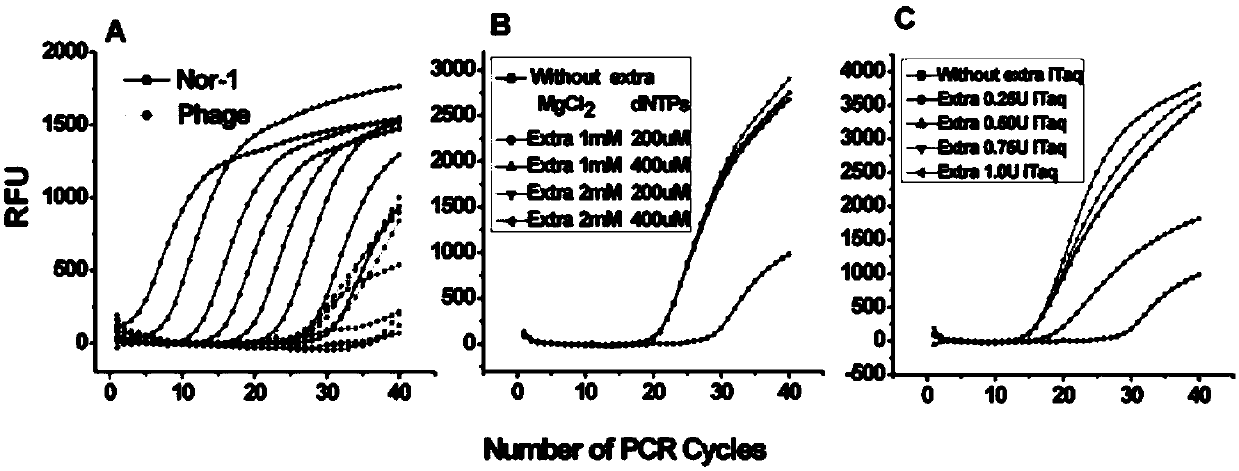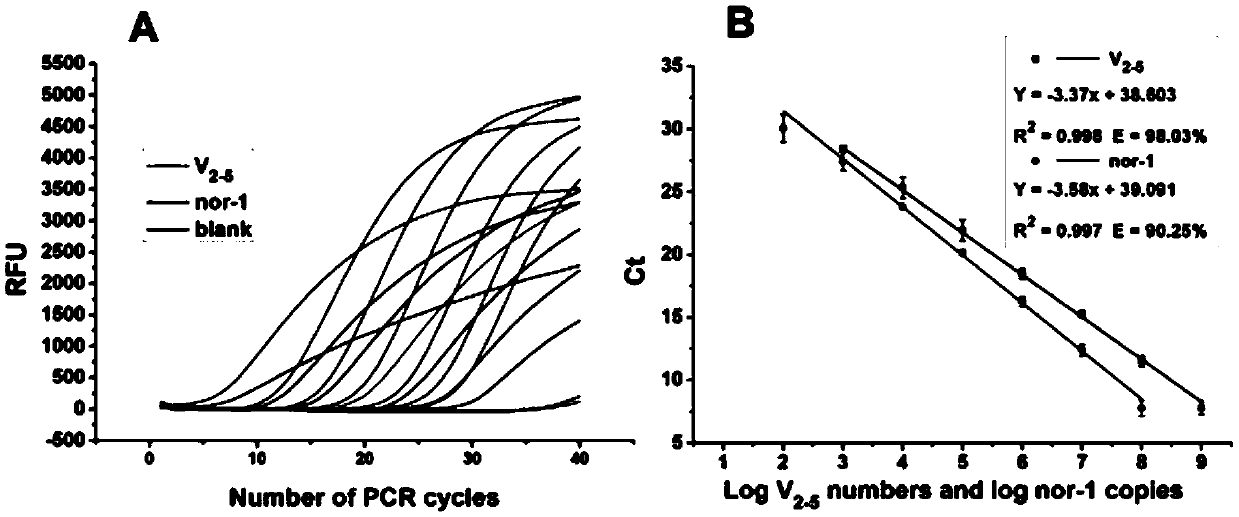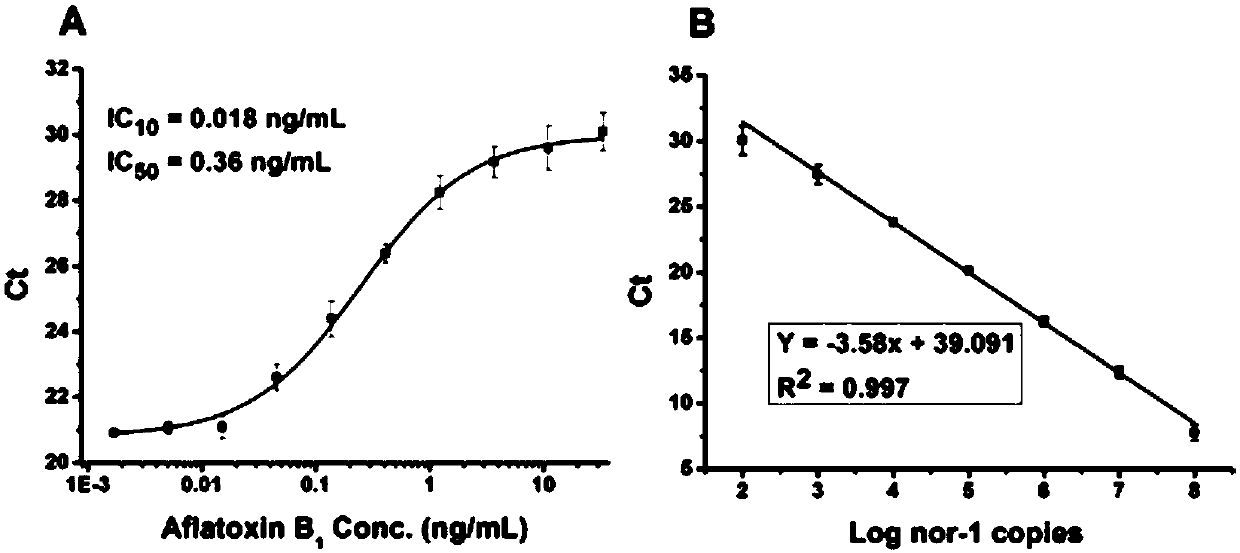Method for identifying and evaluating toxigenic capability of toxigenic strain of aflatoxin
A technology of aflatoxin and Aspergillus flavus strains, applied in the biological field, can solve the problems of gene deletion and false results related to toxin production, and achieve the effects of optimizing the experimental process and structure, reliable ratio results, and accurate identification and evaluation
- Summary
- Abstract
- Description
- Claims
- Application Information
AI Technical Summary
Problems solved by technology
Method used
Image
Examples
Embodiment 1
[0037] 1. The research has proved that the ratio of aflatoxin production to Nor-1 gene transcription has very good relative stability
[0038] Weigh 1g NaNO 3 , 1g K 2 HPO 4 , 0.5g MgSO 4 ·7H 2 O, 0.5g KCl, 0.01g FeSO 4 , 30 g of glucose and 20 g of agar powder were made up to a total volume of 1000 ml with deionized water, and sterilized by high-temperature steam at 121° C. for 30 minutes to prepare a CDA medium. The Aspergillus flavus strain was cultivated for 10 days at 28° C. and 90% humidity with CDA solid culture, and then the culture plate was washed with 20% Tween-20 to obtain the Aspergillus flavus spore solution. The Aspergillus flavus spore solution was oscillated evenly with a vortex shaker by the hemocytometer plate counting method, and the Aspergillus flavus spore solution was microscopically counted with a microscope.
[0039] Put 15mL potato dextrose liquid culture medium in a 50mL Erlenmeyer flask, autoclave at 121°C for 30min, add Aspergillus flavus spo...
Embodiment 2
[0046] The establishment of the simultaneous detection RT-PCR method of embodiment 2 aflatoxin output and Nor-1 gene transcription amount
[0047] Using the existing phage VHH 2-5 displaying aflatoxin anti-idiotypic nanobody on the surface and the nor-1 gene DNA fragment Tq-nor1, a RT-PCR method for simultaneous detection of aflatoxin production and Nor-1 gene transcription was established According to the above detection results as the scientific basis for the identification and evaluation of the virulence of Aspergillus flavus strains, it provides method support for the rapid identification and evaluation of the virulence of Aspergillus flavus strains. These specific steps are as follows.
[0048] The phage VHH 2-5 displaying aflatoxin anti-idiotypic nanobodies on the surface was developed by the Quality Inspection Center of the Institute of Oil Crops, Chinese Academy of Agricultural Sciences, and has been published in the journal literature "Yanru Wang; Peiwu Li; ZuzanaMajk...
Embodiment 3
[0097] 1. The comparative analysis of the virulence of Aspergillus flavus was evaluated by Nor-1 transcript and AFT / Nor-1 (ratio of toxin production and nor-1 transcript) respectively
[0098] Through the comparative analysis of the results, we found that if the virulence of Aspergillus flavus was evaluated only from the amount of nor-1 transcript, the identification result was unreliable. For example, in Aspergillus flavus strains Pc124-2 and Pc34-1, the logarithms of the copy number of nor-1 gene expression were 7.85±0.52 and 6.75±0.58, respectively, and the expression levels of nor-1 gene in the two strains were similar; The yield of aspergillus toxin was 66.5±4.93ng / mL, and the amount of aflatoxin produced by Pc34-1 was only 19.69±2.27ng / mL; in addition, no aflatoxin was detected in CY1, CY2, Pg28-1 and Pc321-1-3 strains. Aspergillus-producing, however, Pg28-1 and Pc321-1-3 expressed even higher levels of the nor-1 gene than some of the aflatoxin-producing strains.
[009...
PUM
 Login to View More
Login to View More Abstract
Description
Claims
Application Information
 Login to View More
Login to View More - R&D
- Intellectual Property
- Life Sciences
- Materials
- Tech Scout
- Unparalleled Data Quality
- Higher Quality Content
- 60% Fewer Hallucinations
Browse by: Latest US Patents, China's latest patents, Technical Efficacy Thesaurus, Application Domain, Technology Topic, Popular Technical Reports.
© 2025 PatSnap. All rights reserved.Legal|Privacy policy|Modern Slavery Act Transparency Statement|Sitemap|About US| Contact US: help@patsnap.com



